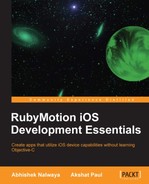A provisioning profile binds numerous digital objects, such as our applications, certificates, and devices, together. A provisioning profile has two parts: one is our development provisioning profile and the other is the distribution profile.
Before we create a new provisioning profile, let's first create an app ID for our application. Inside the provisioning portal, we have a section for creating the app ID. It is necessary to create a new app ID for every application. This app ID is then used while generating a new provisioning profile.

First, we add the description; this is how we will recognize our app ID in our provisioning portal. Next, we add a seed ID. (For first-time users, you will get an option to generate a new one.) Lastly, we add a bundle identifier. We are going to use this bundle identifier in the Rakefile of our RubyMotion project later on. The general nomenclature of naming a bundle identifier is the reverse domain notation, where com is followed by the domain name. In our case I have used packtpub, but you should add your domain name here. In the last part of the bundle identifier, add your application's name; in this case, we will use Restroapp.
For development and testing purposes, we need to add our iOS devices in the Devices section of the application. Inside the Devices section, click on Add Devices as shown in the following screenshot:

To test your application on your iPhone or iPad, simply add the UDID number of your device and a device name of your choice. The UDID number can be seen in iTunes. When you click on the iPhone name, it will show you a 40-digit sequence:

You must add all of the devices you want to test on, which we will be using during development. If the devices you want to test on are not present, the application won't be installed on that device.
Now that we have everything in place to create a new provisioning profile, let's do it by choosing the Provisioning option. The Create new developer profile form is divided into the following four sections:
- Profile Name: This is a label to recognize the profile.
- Certificates: Choose the developer certificate you have installed on your system. If it is a one-man workshop like mine, you will see only one option.
- App ID: Select the one we had created from the previous section for this application.
- Devices: These are the devices you want to test on.

Once you submit this, you will see a pending status. Refresh your browser, and your provisioning profile will be ready. Download it and click on the file, and it will get installed in your Xcode. You can access all of the information related to this provisioning profile by navigating to Xcode | Organiser | Provisioning Profiles | Devices.
